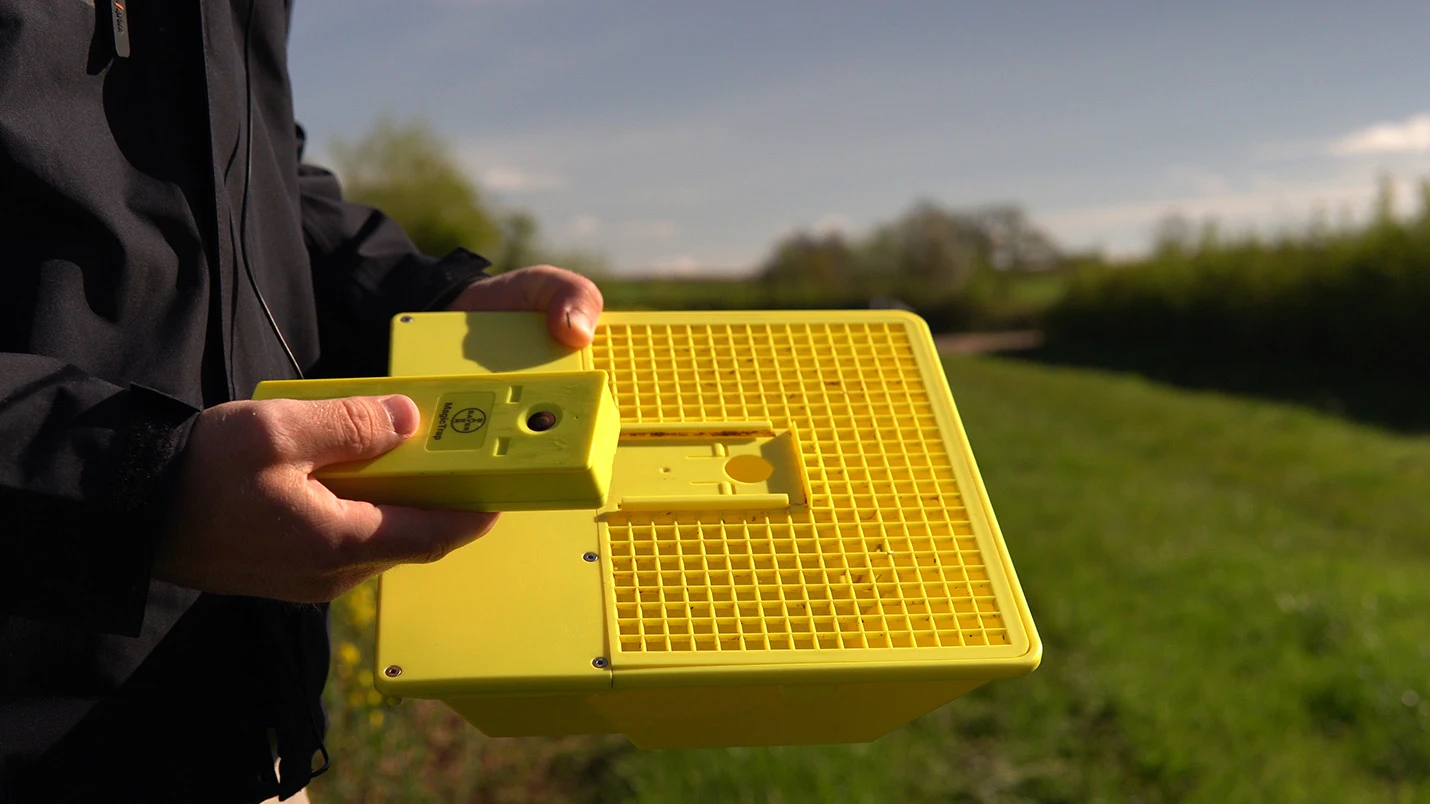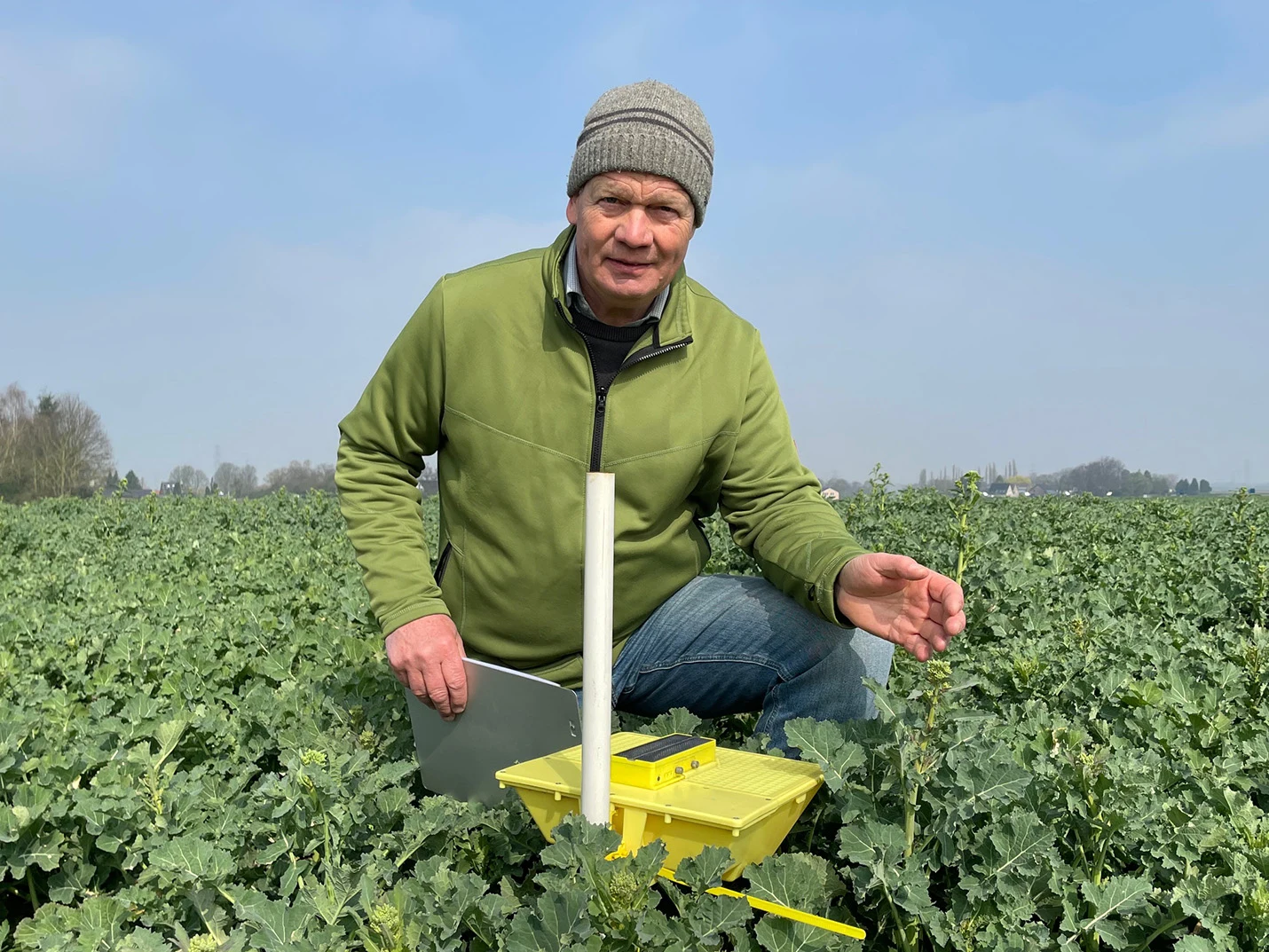
Author
Bayer Crop Science | 25th June 2025Tags
Magic’ technology helping in the battle against CSFB
Cabbage stem flea beetle (CSFB) was not much in evidence in the two MagicTraps deployed at Overbury Enterprises last autumn. Trap counts were low in what was generally a low-pressure season for the oilseed rape pest in most regions.
Farms manager Jake Freestone was using Bayer’s digital yellow water traps for the first time, installing one in low-lying vale land, at around 100ft above sea level and a second on higher hill land at 850ft.

The aim was to monitor how the traps, which were part of the United Oilseeds MagicTrap network, performed at different topographies, on different soil types and in different areas of the farm, which sits on the Herefordshire/Worcestershire border.
CSFB has been a sporadic problem at Overbury since the ban on use of neonicotinoid seed treatments in oilseed rape in 2013.
“It comes and goes; 2018 was a really bad year. I can remember going away for the August Bank Holiday weekend because it was an early harvest and flea beetle ate all the OSR over the weekend,” recalls Jake.
Despite the CSFB challenge, oilseed rape has retained its place in the rotation on the farm, although the area has dropped in recent seasons.
“We're combining about 900 hectares [of arable crops] here and another couple of hundred hectares next door and probably 200 hectares would traditionally have been rapeseed.
“I have persevered with it, although for one reason and another the area had slipped back a little this year but that was mainly down to rotation and we're due to go back up again this year,” says Jake.
With agronomy based on an IPM/ICM approach, a key aim is to avoid using synthetic insecticides where possible.
“We haven’t used insecticides on the farm since 2018,” says Jake. “We use a lot of cultural methods to try and avoid using them.”
Land going into oilseed rape receives an application of poultry litter after the crop has been direct drilled into chopped straw and a decent stubble.
“We also put companion crops in with the rape; we're trying to do everything we can without reaching for an insecticide,” says Jake.
“We did once send some flea beetle off to be tested, and they came back at 77% resistant [to pyrethroid insecticides] so there's probably no point in spraying anyway,” he adds.
Other measures include growing hybrid OSR varieties – typically from the Bayer DEKALB portfolio – to take advantage of their spring vigour and potential ability to grow away from CSFB stem larvae.
Last season’s newcomer DK Excentric is in the variety line-up, alongside Dolphin, for harvest 2025 and is looking well on the higher land, adds Jake.
A shift in OSR drilling date has also been introduced as part of the farm’s approach to managing flea beetle.
“We have started drilling very early, in the first week of August to try and get the OSR up and a leaf established before the main flea beetle migration at the end of August.
“We had pretty good establishment last autumn and flea beetle weren't really an issue. We did have some winter stem larval damage, but the crops seemed to grow through that.”
Jake initially placed the MagicTraps in fields with rape stubble and a cover crop, before moving them into new season crops three weeks after drilling.
“My aim was firstly to get used to the technology and secondly, to have a look at what was emerging from previous oilseed rape fields to try and get a gauge on cabbage stem flea pressure, but there wasn't really very much pressure at all,” he says.
Setting up and using the two MagicTraps was straightforward, although one consideration was dealing with a patchy mobile phone signal.
“I was trying to find a place in the field where I thought the beetle were likely to land, so in the field margins, but also somewhere we could get a signal.
“I found I’d get a signal one day, and then the next day the signal had disappeared. That’s not a particular issue with MagicTrap, it’s a rural issue across the board,” says Jake.
With no insecticides applied on the farm he is not using MagicTrap to inform spraying decisions, instead the benefit comes in the form of saving time on crop walking.
“It also gives me a nice record of what is happening with flea beetle. The fact that MagicTrap is recording a digital footprint means that over time we will hopefully be able to build up a picture of what sort of populations we have, in what fields and in what kind of weather kind of conditions,” he says.
Pollen beetle monitoring
At Bayer’s Forward Farm Damianshof near Monheim in Germany, grower Bernd Olligs is using MagicTrap to monitor pollen beetle and seed weevil in oilseed rape.

The Olligs family has been at Damianshof for six generations, growing sugar beet, potatoes winter wheat, winter oilseed rape, and winter barley on around 115 hectares of high quality Rommerskirchen loess plain soil.
Bayer’s Forward Farming initiative is a global platform and network that showcases modern, sustainable, and climate-smart farming practices, embracing the use of technologies, such as digital tools for precision farming and remote sensing, to improve efficiency and sustainability.
Bernd has been using MagicTrap for five years.
“I think the MagicTrap system is good, and it helps me decide to spray or not to spray,” he says.
“When we have only a few pollen beetle in the traps, I don’t spray. I know that pollen beetle is not going to be a problem and that is enough for me.”
Generating robust data
Following the successful rollout of the United Oilseeds MagicTrap network last year, the aim is to continue to build on the current 48-trap network, says Peter Collier, UOM area manager for the East Anglia region.
“Last year we learnt a lot around what works best in terms of MagicTrap field positioning, timing and best practice. Now we've got many more traps in our network and being shared with us, there is a lot more coverage and we can be increasingly scientific in our approach,” he says.
“In order to get a metric of cabbage stem flea beetle, pollen beetles and weevil numbers, we want consistent placing of a traps within a field. We’ve been standardising our approach across the MagicTrap network to achieve that.
“A single trap on its own provides good information for that farm, but with a consistent way of doing things, then on aggregate, the data is more meaningful for a national picture, and good data in enables good data out,” says Peter.